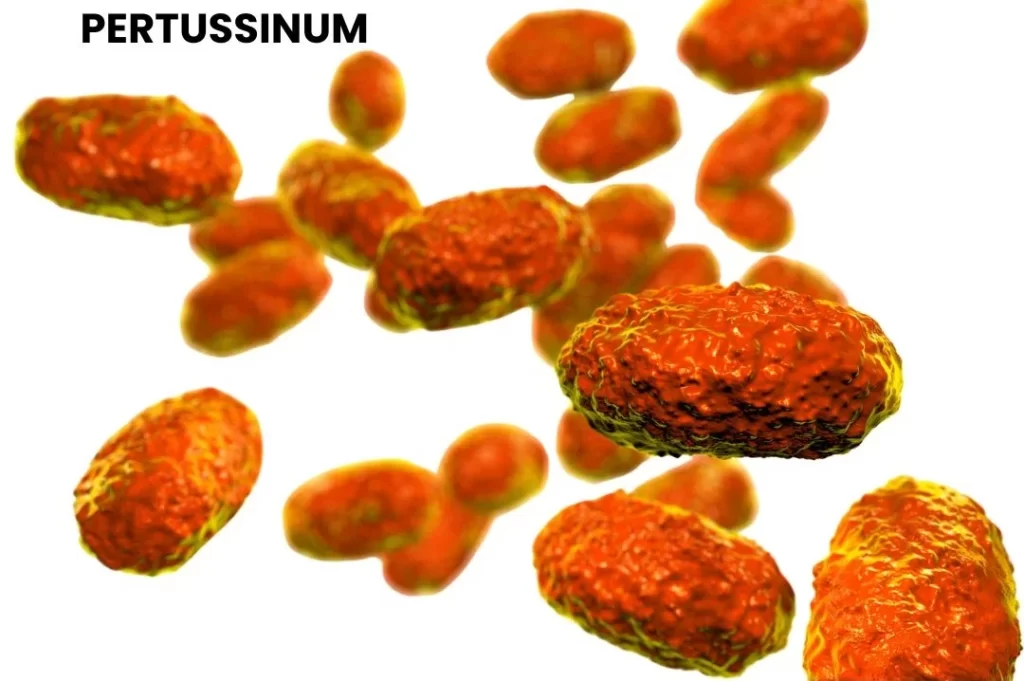Pertussinum, also known as Coqueluchin, is a homeopathic remedy derived from the mucus containing the virus of whooping cough (pertussis).
It was introduced by Dr. John H. Clarke for the treatment of whooping cough and other spasmodic coughs.

Table of Contents
ToggleSOURCE INFORMATION
- Substance: Mucus containing the virus of whooping cough (pertussis)
- Common Name: Pertussinum, Coqueluchin
Origin and Historical Facts
- Origin: Pertussinum is prepared from the glairy and stringy mucus that contains the virus of whooping cough.
- This virus, Bordetella pertussis, is responsible for the highly contagious respiratory disease.
- Historical Usage: Pertussinum was introduced by Dr. John H. Clarke, a prominent British homeopath, specifically for the treatment of whooping cough.
- Over time, it has also been used to address other types of spasmodic coughs.
- Medicinal Uses: Traditionally, this remedy has been employed to alleviate the severe coughing fits associated with whooping cough, and to provide relief from other similar spasmodic cough conditions.
DRUG PATHOGENESIS
- Pertussinum acts primarily on the respiratory system, targeting the spasmodic cough reflex.
- It helps to reduce the frequency and severity of coughing fits, particularly those characterized by the “whoop” sound typical of whooping cough.
KEY CHARACTERISTICS
- Whooping Cough: Effective in treating the spasmodic cough and severe fits associated with whooping cough.
- Spasmodic Coughs: Helps alleviate various types of spasmodic coughs, not limited to whooping cough.
- Respiratory Relief: Provides relief from the intense coughing that can lead to vomiting, exhaustion, and other complications.
DETAILED ORGAN SYMPTOMS
RESPIRATORY SYSTEM
- Whooping Cough: Characterized by severe coughing fits followed by a high-pitched “whoop” sound.
- Spasmodic Coughs: Sudden, intense coughing spells that may result in difficulty breathing, vomiting, or exhaustion.
- Mucus Production: Presence of glairy and stringy mucus during coughing episodes.
MODALITIES
- Worse: Symptoms often worsen at night or with exposure to cold air.
- Better: Relief is typically observed with warmth and during the day.
WHAT ARE MODALITIES IN HOMOEOPATHY?
RELATIONSHIP WITH OTHER DRUGS
Compare
- Drosera: Used for spasmodic coughs, especially those that are dry and irritating.
- Corallium Rubrum: Effective for violent, spasmodic coughs with rapid succession.
- Cuprum: Used for spasms and severe, paroxysmal coughing.
- Naphthalin: Useful for respiratory conditions with severe coughing.
- Mephitis: Known for its effectiveness in treating whooping cough.
- Passiflora: Used for spasmodic conditions, including coughs.
- Coccus Cacti: Helps with violent coughs that produce thick, stringy mucus.
- Magnesia Phosphorica: Known for its antispasmodic properties.
DOSE
- Potency: The thirtieth potency (30C) is commonly used for Pertussinum.
- Administration: It is typically taken in homeopathic doses as prescribed by a qualified practitioner.
Frequently Asked Questions
What is Pertussinum used for?
- Pertussinum is primarily used for treating whooping cough and other types of spasmodic coughs.
- It helps to reduce the severity and frequency of coughing fits.
Is Pertussinum safe to use?
- When used in recommended homeopathic potencies, Pertussinum is generally safe.
- However, it is important to consult with a qualified homeopathic practitioner for proper dosage and administration.
What are the side effects of Pertussinum?
- Side effects are rare when used in homeopathic potencies.
- Inappropriate use or overdosing may lead to an aggravation of symptoms. Always consult with a homeopathic practitioner for proper guidance.
Glossary of Difficult Words
- Spasmodic: Relating to or affected by spasms.
- Glairy: Resembling egg white in consistency; clear and sticky.
- Paroxysmal: Sudden recurrence or intensification of symptoms.
- Antispasmodic: A drug or substance that suppresses muscle spasms.
- Potency: The strength of a homeopathic remedy, indicated by the number of times it has been diluted and succussed (shaken).
By understanding the detailed drug picture of Pertussinum, individuals and practitioners can make informed decisions regarding its use in treating whooping cough and other similar respiratory conditions.
